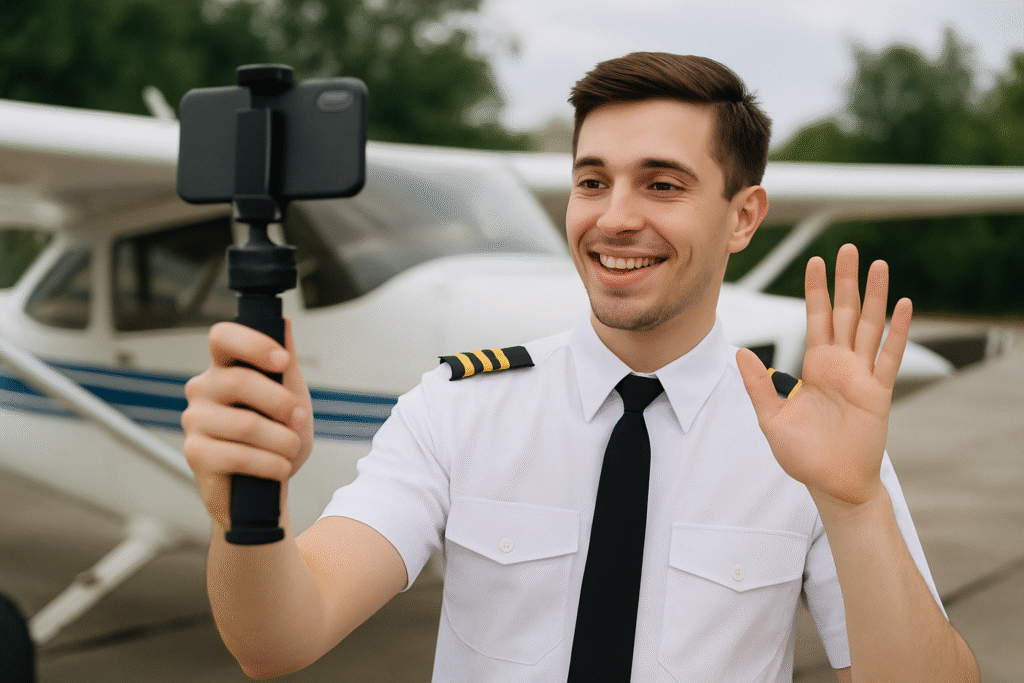In the last decade, social media has reshaped how the aviation community connects, learns, and shares. Platforms like Instagram, YouTube, and TikTok are filled with cockpit views, simulator tips, time-lapse flights, and aviation memes. While this digital exposure has fuelled the dreams of thousands of aspiring pilots, it has also created an online environment filled with pressure, performance anxiety, and misinformation.
For student pilots especially, the impact of social media is more personal than it seems.
🌟 The Bright Side: Empowering a New Generation of Pilots
1. A Window into the Skies
Social media has brought aviation to everyone’s fingertips. Watching cockpit views or airline day-in-the-life vlogs gives young aspirants a realistic glimpse into what it’s like to fly professionally. For many, these visuals are more impactful than textbooks or advertisements.
2. Free Learning Resources
From radio phraseology breakdowns to flight maneuvers explained in short reels, social media has made aviation knowledge more accessible than ever. Many CFI-certified creators share free content to help students prepare for exams, interviews, and flight training modules. This democratization of information helps bridge gaps—especially for students who may not have immediate access to formal aviation schools.
3. A Global Community
Aviation is no longer a lonely path. Students can now join global groups, follow cadets in other countries, interact with airline pilots, and learn from a variety of career journeys. Shared struggles and achievements foster a sense of belonging. This networking can also lead to mentorships, job insights, or even training opportunities.
4. Documenting the Journey
Sharing your own flight progress—first solo, checkride, simulator experience—can be deeply rewarding. It’s also a way to inspire others who are just starting or still considering this career. These posts become digital milestones of hard work and perseverance.

⚠️The Dark Side: The Hidden Costs of Being Online
1. The Comparison Trap
Scrolling through perfectly curated aviation pages showing airline jobs, fast-track careers, and luxurious layovers can lead to self-doubt and burnout. Not every journey is linear, and not every student clears checks or exams in one go. But on social media, struggles are rarely shown—leading others to feel “behind.”
2. Pressure to Perform for the Camera
Many young pilots begin feeling pressure to “post something” to show they’re progressing—even when things are tough. This can turn flying into a performance rather than a learning process. It may also discourage students from asking for help when needed, fearing they’ll look like they’re falling behind.
3. Misinformation and “Shortcut Advice”
Just because a tip goes viral doesn’t mean it’s correct. Many student pilots fall into the trap of following flight hacks, procedures, or theories that are outdated or irrelevant to their region or training authority (DGCA vs FAA vs EASA). Without proper fact-checking, this can lead to confusion, errors, or even unsafe practices.
4. Safety and Privacy Violations
Sharing too much from the cockpit—like control panels, flight logs, or ATC conversations—can breach company policy or aviation safety regulations. Several airlines and flight schools around the world have taken disciplinary action against students or pilots for oversharing or filming during critical phases of flight.
Striking the Right Balance: Tips for Student Pilots
- Follow Reputable Creators: Stick to certified instructors, airline pages, and official training bodies (DGCA/FAA/EASA).
- Learn to Filter: Not everything that trends is true. Cross-check info with your instructors or manuals.
- Celebrate Your Journey—Authentically: Share your progress but don’t feel pressured to match someone else’s timeline.
- Know What Not to Post: Avoid filming during flight, showing confidential material, or posting without permission.
- Use It for Support, Not Comparison: If you’re struggling, connect with others. Many pilots have been through similar phases.
The Social Media Pilot: A New Responsibility
Social media is an amazing tool—but just like flying, it requires discipline, awareness, and responsibility. A good pilot is not just skilled in the air but aware of their image and influence on the ground.
Whether you’re in training or already in the cockpit, remember: your online presence is an extension of your professional reputation. Employers, instructors, and aviation communities are watching—so fly your digital plane with care.
Final Thoughts: Use It, Don’t Be Used by It
At Eazy Pilot, we believe that aviation is not just a career—it’s a mindset. Social media can either build that mindset or break it down.
Used wisely, it can empower, connect, and uplift. Used poorly, it can mislead, distract, or demotivate. Like every tool in aviation, it comes down to how you use it.
So next time you post, scroll, or share, ask yourself:
“Is this helping me become a better pilot—or just a more distracted one?”
Want more aviation insights like this? Subscribe to our blog or follow us on Instagram @eazypilotindia for weekly content on flight training, career tips, and aviation news.